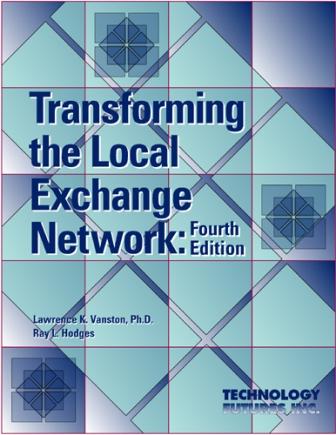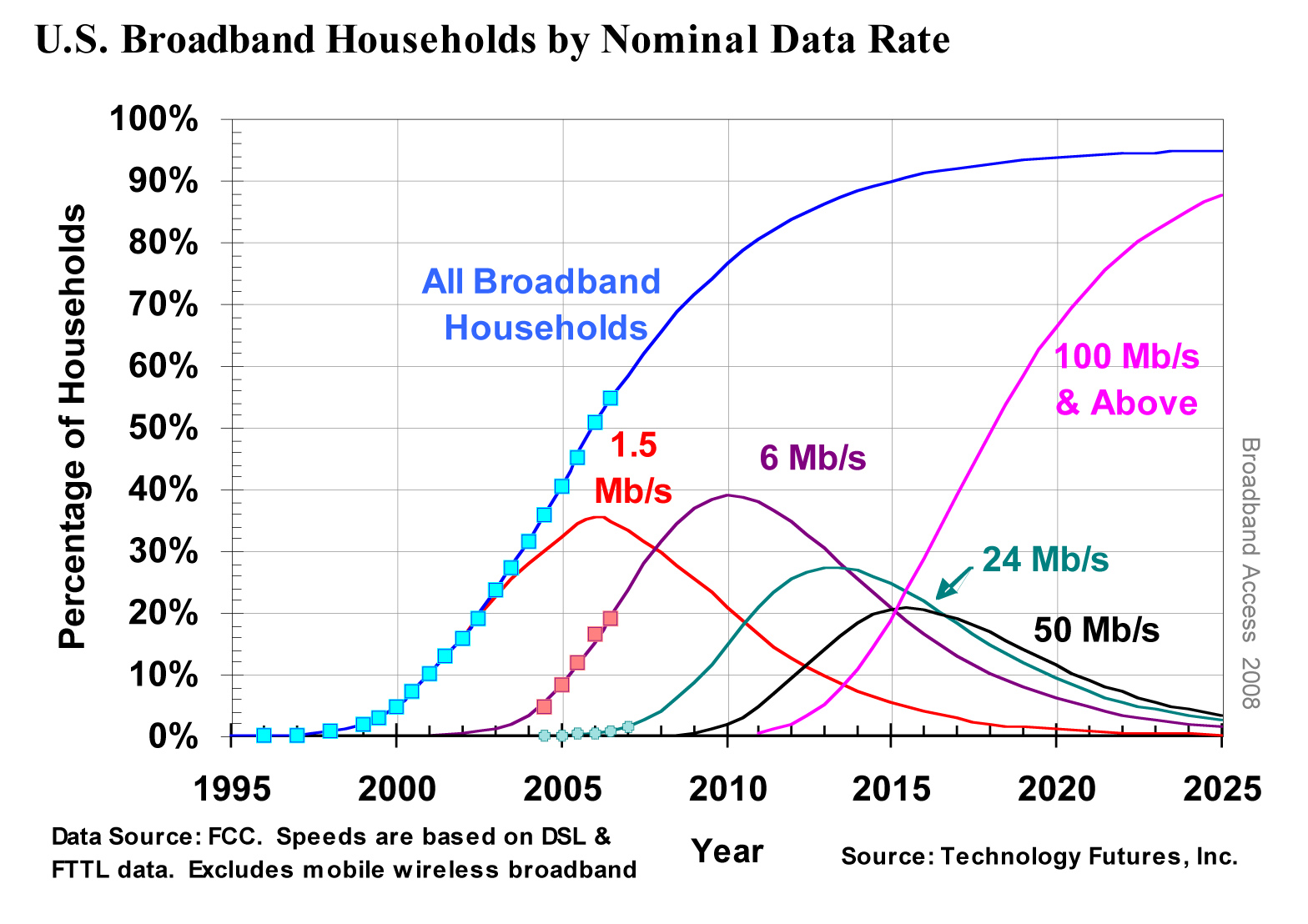Transforming the Local Exchange Network: Fourth Edition
[ordering online? -- please see our return/refund policy]

By Lawrence K. Vanston, Ph.D. & Ray L. Hodges
Description
What You Will Gain
Who Should Read this Report?
Table of Contents
Figures and Featured Graph
Pricing/Ordering information
Sponsored by TTFG
Description [back to top]
TFI announces the availability of the fourth edition of its flagship publication Transforming the Local Exchange Network. This report presents the latest TFI forecasts covering switching, circuit equipment, metallic cable, and fiber cable. The report also includes TFI's latest recommendations on depreciation lives for local exchange telephone plant, recommendations which take into account technology displacement and loss of access lines due to competition.
What You Will Gain [back to top]
- Analysis and quantification of access line loss occurring in the local exchange and its resulting stranding of plants.
- Forecasts of the transition from a narrowband network of circuit switches and copper cables to a broadband network of packet switches and fiber optics.
- Description of what the new network will look like and the combination of services it will offer.
- Forecasts of how quickly technology change and access line losses will affect obsolescence and reduce the lives of telecommunications equipment.
Who Should Read this Report? [back to top]
- Local exchange carriers
- Depreciation professionals
- Property tax professionals
- Regulatory personnel
- Telecom equipment manufacturers
Table of Contents [back to top]
List of Figures and Featured Graph [back to top]
- Chapter 1: Introduction and Summary
- Chapter 2: ILEC Access Line Losses
- Chapter 3: Very-Highspeed-Broadband
- Broadband Internet Access
- Increasing Data Rates
- Forecasts for IP Video
- Online Video
- Internet TV
- IPTV
- High-Definition Television
- Chapter 4: Metallic Cable
- Deployment of VHS Broadband Fiber
- Metallic Feeder Cable
- Metallic Distribution Cable
- Metallic Distribution Cable, FTTP ILECs
- Metallic Distribution Cable, FTTN ILECs
- Metallic Distribution Cable, Industry Composite
- Chapter 5: Non-Metallic Cable
- Chapter 6: Circuit Equipment
- Transport Circuit Equipment
- Narrowband Circuit Equipment
- Standard Broadband Circuit Equipment
- VHS Broadband Equipment
- Circuit Equipment Composite Lives
- Chapter 7: Switching Equipment
- Chapter 8: Conclusion
2.1 U. S. Narrowband Access Lines by Carrier Type 2.2 U. S. Wireline Access Line Displacement 2.3 U. S. Wireless Only Households 2.4 U. S. Adults in Wireless Only Households by Age Group 2.5 U. S, Cable Telephony Access Lines 2.6 U. S. Forecast ILEC Narrowband Access Lines and Broadband Connections 3.1 U. S. Broadband Households 3.2 U. S. Market Shares of DSL, Cable Modems and Fixed Wireless for Standard Broadband 3.3 U.S. Broadband Households by Nominal Data Rate Featured Graph 3.4 Trend in Residential Access Data Rates 3.5 Minimum Availability of 24 Mb/s and above Broadband (VHS Broadband) 3.6 U. S. Online Video Users and Internet TV Users 3.7 Comparison of Internet TV and 6Mb/s and Above Broadband Forecasts 3.8 U. S. HDTV Households 3.9 U. S. Internet HDTV Households 3.10 Comparison of Internet HDTV and 24Mb/s and Above Broadband Forecasts 4.1 Deployment of VHS Broadband Fiber 4.2 Comparison of Deployment of VHS Fiber and VHS Broadband Availability 4.3 Access Lines Converted from Metallic Feeder Cable to VHS Fiber Facilities (Base Scenario) 4.4 Substitution of Metallic Feeder Cable by Fiber Feeder Cable (Base Scenario) 4.5 Percentage of Access Lines on Metallic Feeder Cable (Base Scenario) 4.6a Access Lines Converted from Metallic Feeder Cable to VHS Fiber Facilities (Base Scenario) (Duplicate of Figure 4.3) 4.6b Metallic Feeder Cable Survivor Curves (Base Scenario) 4.7a Access Lines Converted from Metallic Feeder Cable to VHS Fiber Facilities (Late Scenario) 4.7b Metallic Feeder Cable Survivor Curves (Late Scenario) 4.8a Access Lines Converted from Metallic Distribution Cable to VHS Broadband Fiber - FTTP ILECs (Base Scenario) 4.8b Survivor Curves for Metallic Distribution Cable - FTTP ILECs (Base Scenario) 4.9a Access Lines Converted from Metallic Distribution Cable to VHS Broadband Fiber - FTTP ILECs (Late Scenario) 4.9b Survivor Curves for Metallic Distribution Cable - FTTP ILECs (Late Scenario) 4.10 Scenarios for FTTN to FTTP Transition - FTTN ILECs 4.11 Comparison of FTTN to FTTP Transition Scenarios and VHS Broadband Fiber Deployment - FTTN ILECs 4.12a Access Lines Converted from Metallic Distribution Cable to VHS Broadband Fiber - FTTN ILECs (Early Scenario) 4.12b Survivor Curves for Metallic Distribution Cable - FTTN ILECs (Early Scenario) 4.13a Access Lines Converted from Metallic Distribution Cable to VHS Broadband Fiber - FTTN ILECs (Middle Scenario) 4.13b Survivor Curves for Metallic Distribution Cable - FTTN ILECs (Middle Scenario) 4.14a Access Lines Converted from Metallic Distribution Cable to VHS Broadband Fiber - FTTN ILECs (Late Scenario) 4.14b Survivor Curves for Metallic Distribution Cable - FTTN ILECs (Late Scenario) 4.15a Access Lines Converted from Metallic Distribution Cable to VHS Broadband Fiber (Industry Composite) 4.15b Survivor Curves for Metallic Distribution Cable - ILECs (Industry Composite) 5.1 Age-Survivor Curve for Fiber Optic Cable 5.2a Substitution of Full Spectrum Fiber for Standard Single-Mode Fiber Optic Cable (Early Scenario) 5.2b Survivor Curves for Standard Single-Mode Fiber Optic Cable (Early Scenario) 5.3a Substitution of Full Spectrum Fiber for Standard Single-Mode Fiber Optic Cable (Middle Scenario) 5.3b Survivor Curves for Standard Single-Mode Fiber Optic Cable (Middle Scenario) 5.4a Substitution of Full Spectrum Fiber for Standard Single-Mode Fiber Optic Cable (Late Scenario) 5.4b Survivor Curves for Standard Single-Mode Fiber Optic Cable (Late Scenario) 6.1 Surviving Value and Depreciation Lives for Transport Circuit Equipment 6.2 Survivor Curves for Narrowband Circuit Equipment (Base Scenario) 6.3 Survivor Curves for Narrowband Circuit Equipment (Late Scenario) 6.4a Standard Broadband Circuit Equipment (Base Scenario) 6.4b Survivor Curve for Standard Broadband Circuit Equipment (Base Scenario) 6.5a Standard Broadband Circuit Equipment (Late Scenario) 6.5b Survivor Curve for Standard Broadband Circuit Equipment (Late Scenario) 6.6a Survivor Curves for Circuit Equipment, excluding VHS Broadband Equipment (Base Scenario) 6.6b Composite Survivor Curves for Circuit Equipment, excluding VHS Broadband Equipment (Base Scenario) 6.7a Survivor Curves for Circuit Equipment, excluding VHS Broadband Equipment (Late Scenario) 6.7b Composite Survivor Curves for Circuit Equipment, excluding VHS Broadband Equipment (Late Scenario) 7.1 Voice and Data Traffic 7.2a Substitution of Packet Switching for Circuit Switching (Base Scenario) 7.2b Survivor Curves for Digital Circuit Switching (Base Scenario) 7.3a Substitution of Packet Switching for Circuit Switching (Late Scenario) 7.3b Survivor Curves for Digital Circuit Switching (Late Scenario) 7.4 Access Lines Converted to Packet Switching (Base Scenario) 7.5 Access Lines Converted to Packet Switching (Late Scenario)
Pricing/Ordering Information [back to top]
November 2008, 86 pages, ISBN # 1-884154-33-6
Texas residents add 7.25% (Austin, Texas 8.25%) sales tax.
Call for TTFG member prices and volume discounts.


